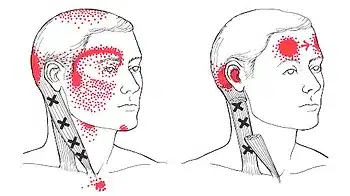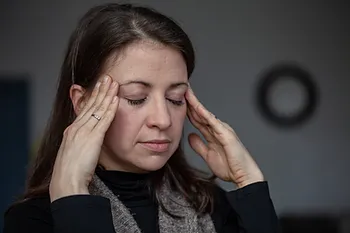There are so many people who come to see us for Neck Pain who do not realize that the headaches that they have had off and on for years are related to their neck problem…they may even be a warning sign for their upcoming neck pain.
When someone comes in to see us with neck pain, they are very often surprised when I ask about their headaches…and that my concern for the exact pattern of their headaches is something that they have never been asked before.

Many of these people have had headaches that follow a specific pattern that have often progressed to a diagnosis of migraines, yet get very little relief from the medications…
…That’s because they aren’t really migraines, but are something called Cervical Headaches—and follow very specific patterns with very specific causes.
What is a Cervical Headache?
A cervical headache is just that, a headache caused by neck issues. They can happen before any development of neck pain, at the same time as the neck pain, or even a while after the neck pain.
They, also, tend to follow a pattern in time of day or activity dependency. Cervical headaches are most common at the end of the day, first thing in the morning, and/or after spending a lot of time on a computer or device.
At the end of the day, your neck muscles fatigue from the long days of holding your head up (most likely, not in an optimal position) while driving, working, lifting, cooking, reading my latest blog on your phone (or scrolling through Facebook), and just “life-ing”, which causes some very specific tightening of the muscles that can cause headaches.
The morning headaches can be slightly different and are caused by the same reasons as the headaches caused by working on the computer or looking at your device. Whether it’s the device or sleeping, your head has been still in a forward head position for a long time, which puts strain on your neck muscles, allows the slacked muscles to tighten, and causes a strain when they are pulled on. The curled-up posture DOES take more time to cause the pain than the slouched posture during the day, because during the day, your muscles have to fight gravity.
What is the Difference Between Cervical Headaches and Migraines?
Cervical Headaches are usually mechanical in nature and follow specific timing and activity patterns, such as at the end of the day or after computer usage. They, also, have some form of neck stiffness or neck pain associated with the headache. This neck stiffness may or may not be noticeable if you have ever had a history of neck injury or just are prone a neck stiffness that most of us just think it’s from “getting old”.
Cervical Headaches can also travel to the jaw, down the neck, or even down into the arm. This happens because of the involvement of the neck and the tight structures pulling on the jaw or pinching on the nerves that exit the neck and go down into the arm.
While Cervical Headaches are related to positioning and follow specific referral patterns that go into the eye or side of the head (we’ll get to these patterns soon), Migraines are more related to stress and eye fatigue. Migraines do not have a neck stiffness component, usually are on both sides of the head and do not follow the cervical referral patterns.
The best trick I can give you to determine if it is a Cervical Headache or Migraine is to lay flat on the bed, close your eyes and stay still for 5 minutes. If the headache decreases at all, it is most likely related to a cervical problems, where Migraines usually do not calm down as quickly.
And to be 10% honest, there is always a possibility of the Cervical Headache triggering a Migraine in people who have had Migraines in the past. However, the Cervical Headache can be traced back to the neck pain and mechanical activites.
Why Do Cervical Headache Happen?
Most Cervical Headaches are related to two muscles groups in the neck pulling on the Fascia of the head and causing the pain to go to the head in specific places.
Fascia is the tissue in the body that no one really talks about…probably because it’s hard to understand how it affects the body and why it causes the problems that it does. Understanding what it looks like is a little easier…Fascia is that thin, clear coating on the muscles and around the bone that you see in the piece of chicken, just under the skin or between the pieces of meat (especially where the chicken meat fibers change direction—gross, I know. Fascia is your body’s spacer, giving it a wrapping to define each structure from the other and giving you the orderly structures that you may have learned in Anatomy class, way back when.
The Fascia in the skull keeps the skin apart from the bone, attaches to the muscles of your face that make expressions giving them a structure to pull on without moving a bone, and protect the skull by being highly innervated (meaning there are lots of nerves in the fascia to help tell when you hit your head).
The Strenoclydomastoid muscle and the Suboccipital groups of muscles do have some fibers the attach into specific places on your skull that happen to be at the ends of that fascia. These muscles are slacked when you slouch or curl up, which happens when you sleep in a ball, lean forward to see the computer or your iPhone, or just plain fatigue after a long day. Those slacked muscles tighten over time and put a low level of pull on that fascia, which causes a cervical headache.
The suboccipitals are at the base of the skull in the back of your neck. Their job is to cause little movements in the head to help your eyes stay fixed on whatever you are lowing at. With a forward head posture, the suboccipitals are slacked and begin to tighten, causing the pain pattern in the picture below.

The strenocleidomastoid (SCM) muscles are located on the front of your neck and attach from the sternum and clavical (collar bone) to the mastoid process (a bone that looks like a spike sticking down from the skull just behind your ear). The SCM muscles have a huge role in turning your head and/or lifting your head up when laying on your back. If they tighten, they give the referral pattern below.

How Can I Stop These Headaches?
- Make sure you are sitting in a good posture, especially when driving, using a computer, or scrolling through your favorite social media platform (yes, tictok can cause headaches, not just from the annoying content).
- Stop sleeping in a ball and get that head back and straight on the pillow (a Pillowise pillow can help…just stop by for your free measurement and trial).
- Stretch your Neck
- There are various manual therapy techniques that we use to release the subocciptals and SCM to decrease the pain—along with some home self-treatment techniques to use once we figure out the true cause
- Stop the problem in the first place with some Physical Therapy.
We can Help!
If you are not sure if your headaches are Migraines or are Cervical in nature, we can help. Click Here to Request a Free Consultation to speak a therapist who will help you determine if your headache is from your neck…no obligation to do therapy, just a true honest answer on if you have a Migraine or a Cervical Headache—all we ask is that after we tell you which it is that you give us a few minutes to tell you how we can help.
If you know it’s your neck that is causing the problem, but are not ready to talk to us, CLICK HERE to request our FREE guide on “The 7 Simple Strategies to Live with Less Neck Pain” to get started to decrease your neck pain and headaches.

